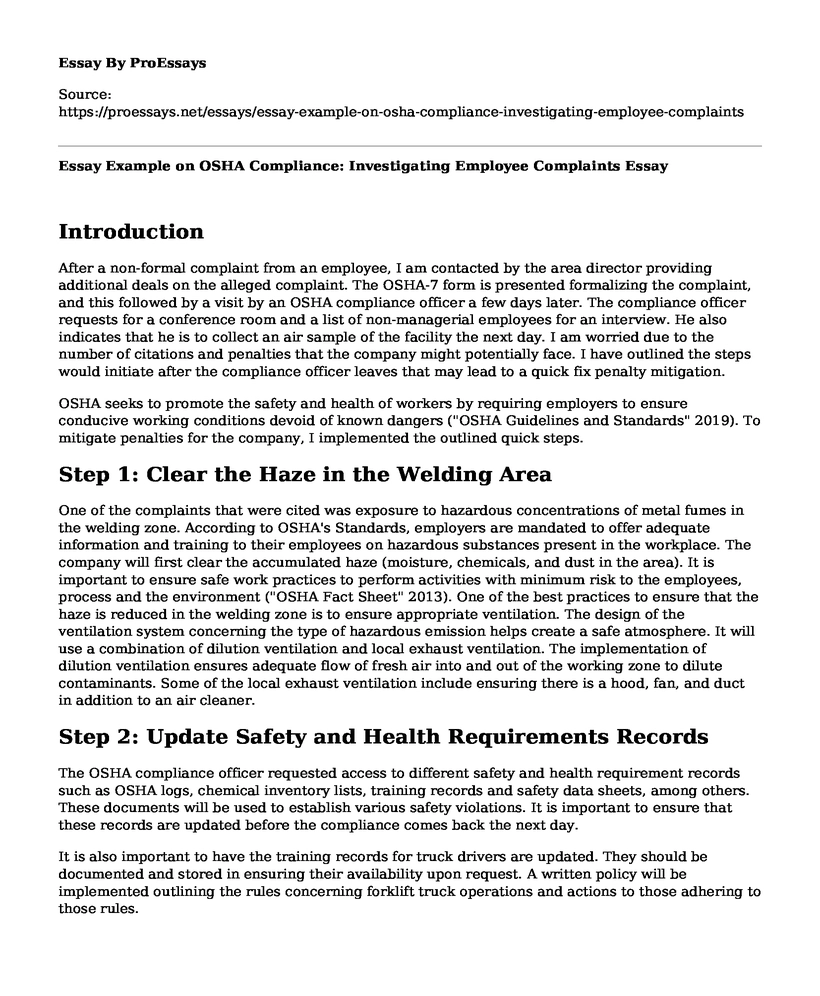Introduction
After a non-formal complaint from an employee, I am contacted by the area director providing additional deals on the alleged complaint. The OSHA-7 form is presented formalizing the complaint, and this followed by a visit by an OSHA compliance officer a few days later. The compliance officer requests for a conference room and a list of non-managerial employees for an interview. He also indicates that he is to collect an air sample of the facility the next day. I am worried due to the number of citations and penalties that the company might potentially face. I have outlined the steps would initiate after the compliance officer leaves that may lead to a quick fix penalty mitigation.
OSHA seeks to promote the safety and health of workers by requiring employers to ensure conducive working conditions devoid of known dangers ("OSHA Guidelines and Standards" 2019). To mitigate penalties for the company, I implemented the outlined quick steps.
Step 1: Clear the Haze in the Welding Area
One of the complaints that were cited was exposure to hazardous concentrations of metal fumes in the welding zone. According to OSHA's Standards, employers are mandated to offer adequate information and training to their employees on hazardous substances present in the workplace. The company will first clear the accumulated haze (moisture, chemicals, and dust in the area). It is important to ensure safe work practices to perform activities with minimum risk to the employees, process and the environment ("OSHA Fact Sheet" 2013). One of the best practices to ensure that the haze is reduced in the welding zone is to ensure appropriate ventilation. The design of the ventilation system concerning the type of hazardous emission helps create a safe atmosphere. It will use a combination of dilution ventilation and local exhaust ventilation. The implementation of dilution ventilation ensures adequate flow of fresh air into and out of the working zone to dilute contaminants. Some of the local exhaust ventilation include ensuring there is a hood, fan, and duct in addition to an air cleaner.
Step 2: Update Safety and Health Requirements Records
The OSHA compliance officer requested access to different safety and health requirement records such as OSHA logs, chemical inventory lists, training records and safety data sheets, among others. These documents will be used to establish various safety violations. It is important to ensure that these records are updated before the compliance comes back the next day.
It is also important to have the training records for truck drivers are updated. They should be documented and stored in ensuring their availability upon request. A written policy will be implemented outlining the rules concerning forklift truck operations and actions to those adhering to those rules.
Step 3: Employees have Personal Protective Equipment
Another quick fix action is to ensure that appropriate use of personal protective equipment to reduce exposure to hazardous materials as mandated by OSHA ("Personal Protective Equipment" 2004). First, it is important to ensure that employees with full beards and using half-mask air-purifying respirators shave. The supervisors shall identify all employees that required air purifying equipment in their job tasks. Employees will also be required to use gloves in handling chemicals that might affect the skin.
Step 4: Implement Appropriate Emergency Mechanism
The company will have safety technicians assess and update safety inspection logs and ensure the installation of eyewash stations. All stations that involve the use of chemicals will have eye stations located nearby. It is important to apply no lock-out/tag mechanism and train employees appropriately. Also, all machines requiring this mechanism will have a written procedure.
Step 5: Ensure Access to SDS
I will ensure safety data sheets are available to employees when they require them. The use of the SDS will help employees identify hazards of products they are using and therefore protect themselves appropriately. Also, all containers should be labelled to indicate the material they contain for easy identification.
Step 6: Ensure Cords are organized
It is important to ensure that extension cords are not in the walkways by placing cord guards or placing them away from the walks ways.
Conclusion
The quick fix penalty mitigations procedures are essential in preventing extensive citations that might negative the company or even result in its closure. In addition to the reduction of the increase citations, it will help in mitigation of injuries to employees and therefore improve safety and health.
References
OSHA Fact Sheet: Controlling Hazardous Fume and Gases during Welding. (2013). Retrieved February 2, 2020, from https://www.osha.gov/Publications/OSHA_FS-3647_Welding.pdf
OSHA Guidelines and Standards. (2019). Retrieved February 2, 2020, from https://www.osap.org/page/GuideOSHA
Personal Protective Equipment. (2004). Retrieved February 2, 2020, from https://www.osha.gov/Publications/osha3151.pdf
Cite this page
Essay Example on OSHA Compliance: Investigating Employee Complaints. (2023, Mar 28). Retrieved from https://proessays.net/essays/essay-example-on-osha-compliance-investigating-employee-complaints
If you are the original author of this essay and no longer wish to have it published on the ProEssays website, please click below to request its removal:
- Supply Chain Management in Apple Inc. and Zara: Course Work Example
- Marketing Report Sample on Nike Company
- Amazon Strategy Evaluation Report Paper Example
- Employers Must Provide Acceptable Health Insurance Coverage to Avoid Fines - Essay Sample
- Expatriate Employees: Rewarding for Successful Overseas Branches - Essay Sample
- Competition for Apple in the Market - Essay Sample
- Mgmt Morally Liable for Employees' Deaths: Poor Working Conditions - Essay Sample







